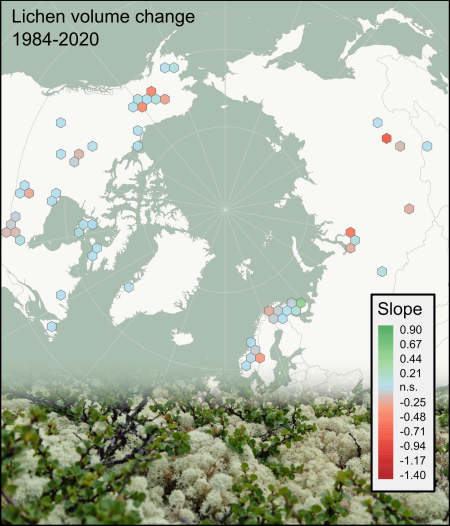The PhD defence and trial lecture will be held in Auditorium 1 in The Geology Building. In some cases, it will be possible to attend the trial lecture and dissertation digitally, in that case a link to Zoom will be posted.
Join via Zoom (webinar)
Trial lecture
Wednesday 12 June, 10:15-11:00, Aud 1, The Geology Building:
Vegetation-climate interaction at the global scale
Conferral summary (in Norwegian)
Lav og mose utgjør en viktig del av floraen og er ofte dominerende vegetasjon på høye breddegrader. Imidlertid er det lite kunnskap om deres betydning og rolle i interaksjonen mellom vegetasjon og klima. I dette doktorgradsarbeidet vises hvordan lav har en viktig klimaregulerende effekt gjennom å høyne overflatealbedo for solinnstråling, hvordan lavrik vegetasjon har endret seg de siste 40 årene, og hvordan varmere og mer ustabile vintre kan påvirke lavrike økosystemer.
Main research findings
Popular scientific article about Finne’s dissertation:
On the role of lichens in vegetation-climate interactions
Current climate change is amplified over northern high latitudes, affecting the biogeochemical interactions between vegetation and the climate. However, the role of lichens, bryophytes and soil crust communities in these interactions are not well understood. This doctoral thesis focuses on bright, ground-covering lichens and their function in land-climate interactions, changes to their distribution, and responses to winter climate change.
In this study we find that land surfaces covered by bright types of lichens have the highest albedo effect of all naturally occurring vegetation. The high albedo effect is especially important for vegetation-climate interactions at high latitudes, as carbon sequestration is much lower than in warmer biomes. Over the latest 40 years the volume of lichen have declined across the pan-Arctic. From previously being mainly limited by increased grazing pressure from reindeer and caribou, and now higher competition from trees and shrubs under climate change is taking over as the major factor for limiting lichen.
While herbivory, increase in wildfires, and summer warming benefit herbs and shrubs at the expense of lichens, winter heatwaves represent an opposite effect. Lichens prove to be much more robust against the stress of ice encapsulation and midwinter thaw-and-refreezing cycles than vascular plants and bryophytes. Thus, lichens will still be able to compete successfully against vascular vegetation in areas where unstable winter conditions drive vegetation dynamics.

Photo and other information:
Press photo: Eirik Aasmo Finne, portrait; 1000px. Photo: Private
Other photo material: Figure with description and credit as specified in the article above, size 2000px.
